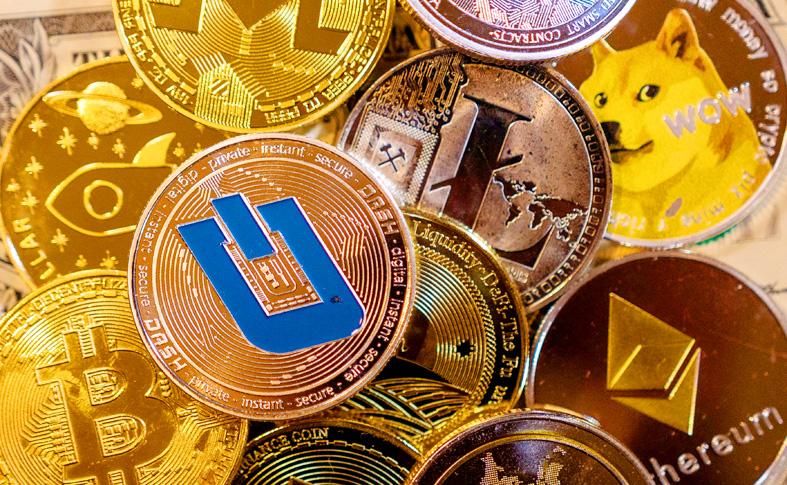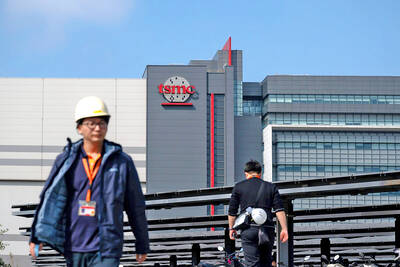One of cryptocurrency’s spiritual forebears, Timothy May, predicted in the 1990s that untraceable digital cash would allow online casinos, bank secrecy and money laundering to flourish. Although laws would be dodged, he said, the individual anonymity and freedom would be worth it — at least, until the inevitable government backlash.
This cycle is playing out almost three decades later, as regulators take a fresh crack at the US$2.4 trillion cryptosector that has ballooned largely out of their reach.
Crypto executives were grilled by US lawmakers on Wednesday after a series of probes and fines into trading platforms amid a post-COVID-19 digital gold rush.

Photo: Reuters
The bosses acknowledged the need for more oversight, but warned that draconian rules would chase firms overseas.
The march toward more regulation is under way, and for good reason. While the execs defended their work policing bad actors, for the most part, anti-money laundering standards and client identification controls still look patchy.
One survey of 16 platforms in March found that only four were subject to “significant” rules related to trading. Exchange activity primarily takes place in offshore jurisdictions.
Binance, with no formal head office, is described as being “everywhere and nowhere.” Theft, fraud and hacks are rife.
Yet what is more unnerving is the pace at which sophisticated investors — not just cyberpunters eager to make a buck — have thrown cash at trading venues regardless. Venture capitalists (VCs) have invested more than US$27 billion in crypto start-ups this year, according to PitchBook, including a US$1 billion funding round for Bahamas-based FTX.
In May, a firm backed by billionaires Peter Thiel and Alan Howard injected US$10 billion of digital assets and cash into Gibraltar-licensed firm Bullish Global. Binance narrowly failed to raise US$100 million earlier this year; it is trying again.
VCs obviously have experience with risky bets on firms that disrupt the rules. It is a tried-and-tested template: Move fast, break things and then ask for forgiveness. Regulation is always catching up. Europe’s gig economy rules targeting the likes of Deliveroo Holdings PLC and Uber Technologies Inc have only come after years of the firms’ empire-building, for example.
Still, it seems rather brave for VCs to be diving head-first into a cryptomarket with opaque actors and enough financial risk that the Bank of England compares it to the 2008 financial crisis — itself a product of “innovation” in mortgage finance.
The “cypher-punk”-meets-Silicon-Valley enthusiasm has reached institutional investors who are not VCs. Many seem to be tossing aside the kind of counterparty risk management they would rigorously apply in traditional markets just to get a slice of crypto’s potentially vertiginous gains.
Last year, crypto exchange Binance — which this summer was hit with regulatory warnings around the world — reported a 70 percent increase in institutional clients onboarded. Some hedge funds only decided to leave Binance “a bit” after the warnings.
It is time for investors to question whether they have allowed the fear of missing out (FOMO) to take over.
“The legal risk of posting funds within much of this ecosystem cannot be understated,” said Martin Finnegan, partner at Punter Southall Law.
While a regulated venue like the Chicago Mercantile Exchange is designed to guarantee terms of trade and eliminate counterparty, settlement and default risk, unregulated crypto venues have more conflicted roles combining brokerage, safekeeping and lending.
The Futures Industry Association has said that a “significant” amount of activity on unregulated platforms could be wash trading and that basic market data cannot be trusted.
Regulation is already prompting market shifts. New exchanges see playing by the rules as a competitive advantage.
Archax, a London-based exchange that it says is regulated by the British Financial Conduct Authority as a multilateral trading facility, plans to launch next month.
Swarm describes itself as the first decentralized finance platform supervised by Germany’s BaFin. Binance and FTX are investing in regulated platforms; they have both shelved some products.
These shifts would not answer all questions for investors trading crypto.
Bitcoin would still have a questionable environmental footprint in an environmental, social and governance-conscious world; its price tag would still inspire almost scholastic debates over whether it is digital gold, a proxy for equities, or something else entirely.
Central bank digital currency experiments, such as those of France and Switzerland, would keep advancing, with potentially very disruptive results.
However, as regulators try to keep a leash on cyberspeculation, investors should realize that they also have to adjust to a less hospitable world for freewheeling platforms — perhaps sooner than they think.
Lionel Laurent is a Bloomberg Opinion columnist covering the EU and France. He worked previously at Reuters and Forbes.
This column does not necessarily reflect the opinion of the editorial board or Bloomberg LP and its owners.

Apple Inc has closed in on an agreement with OpenAI to use the start-up’s technology on the iPhone, part of a broader push to bring artificial intelligence (AI) features to its devices, people familiar with the matter said. The two sides have been finalizing terms for a pact to use ChatGPT features in Apple’s iOS 18, the next iPhone operating system, said the people, who asked not to be identified because the situation is private. Apple also has held talks with Alphabet Inc’s Google about licensing its Gemini chatbot. Those discussions have not led to an agreement, but are ongoing. An OpenAI

INSATIABLE: Almost all AI innovators are working with the chipmaker to address the rapidly growing AI-related demand for energy-efficient computing power, the CEO said Taiwan Semiconductor Manufacturing Co (TSMC, 台積電) yesterday reported about 60 percent annual growth in revenue for last month, benefiting from rapidly growing demand for artificial intelligence (AI) and high-performance computing applications. Revenue last month expanded to NT$236.02 billion (US$7.28 billion), compared with NT$147.9 billion in April last year, the second-highest level in company history, TSMC said in a statement. On a monthly basis, revenue surged 20.9 percent, from NT$195.21 billion in March. As AI-related applications continue to show strong growth, TSMC expects revenue to expand about 27.6 percent year-on-year during the current quarter to between US$19.6 billion and US$20.4 billion. That would

‘FULL SUPPORT’: Kumamoto Governor Takashi Kimura said he hopes more companies would settle in the prefecture to create an area similar to Taiwan’s Hsinchu Science Park The newly elected governor of Japan’s Kumamoto Prefecture said he is ready to ensure wide-ranging support to woo Taiwan Semiconductor Manufacturing Co (TSMC, 台積電) to build its third Japanese chip factory there. Concerns of groundwater shortages when TSMC’s two plants begin operations in the prefecture’s Kikuyo have spurred discussions about the possibility of tapping unused dam water, Kumamoto Governor Takashi Kimura said in an interview on Saturday. While Kimura said talks about a third plant have yet to occur, Bloomberg had reported TSMC is already considering its third Japanese fab — also in Kumamoto — which would make more advanced chips. “We are

The consumer price index (CPI) last month eased to 1.95 percent, below the central bank’s 2 percent target, as food and entertainment cost increases decelerated, helped by stable egg prices, the Directorate-General of Budget, Accounting and Statistics (DGBAS) said yesterday. The slowdown bucked predictions by policymakers and academics that inflationary pressures would build up following double-digit electricity rate hikes on April 1. “The latest CPI data came after the cost of eating out and rent grew moderately amid mixed international raw material prices,” DGBAS official Tsao Chih-hung (曹志弘) told a news conference in Taipei. The central bank in March raised interest rates by